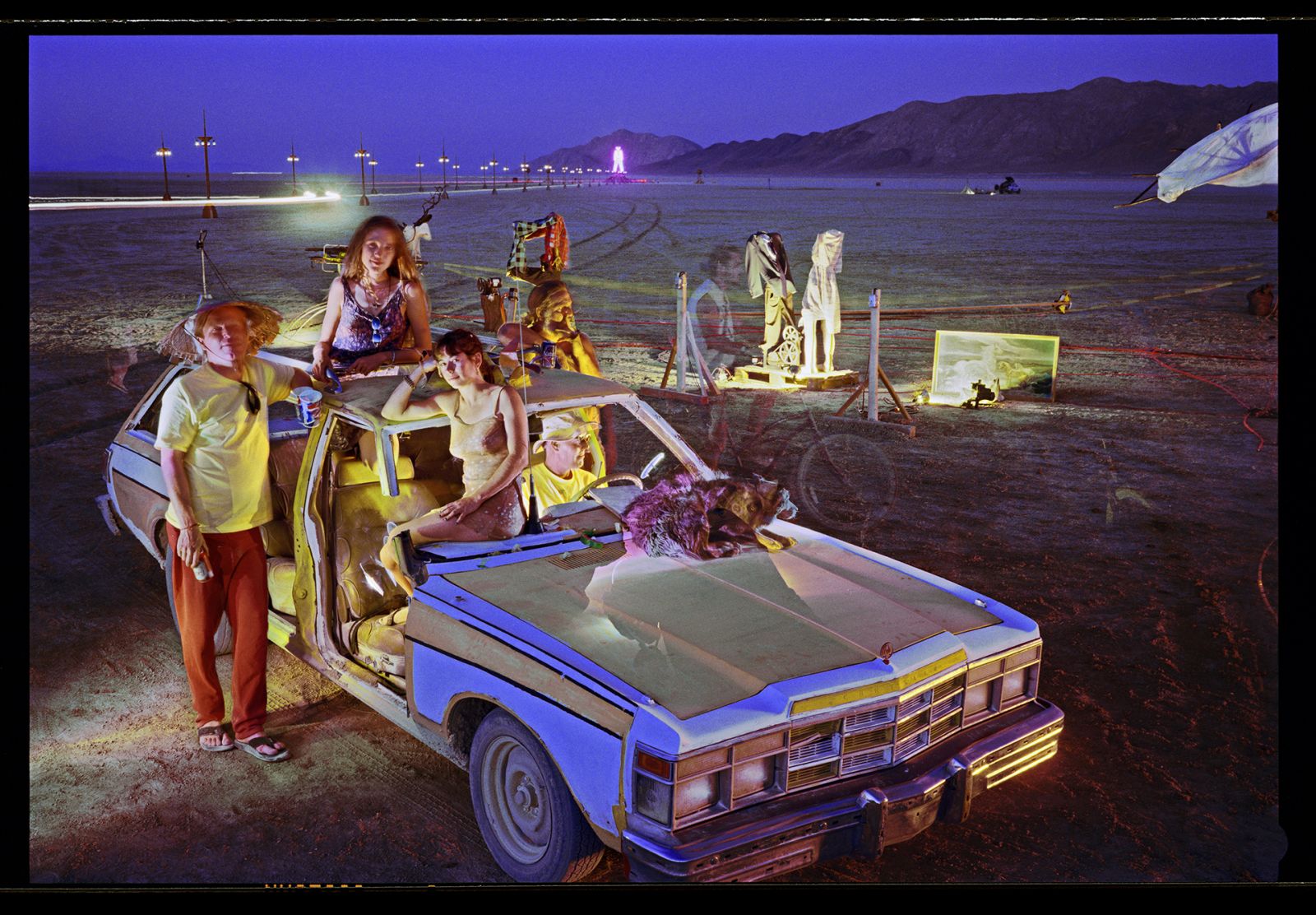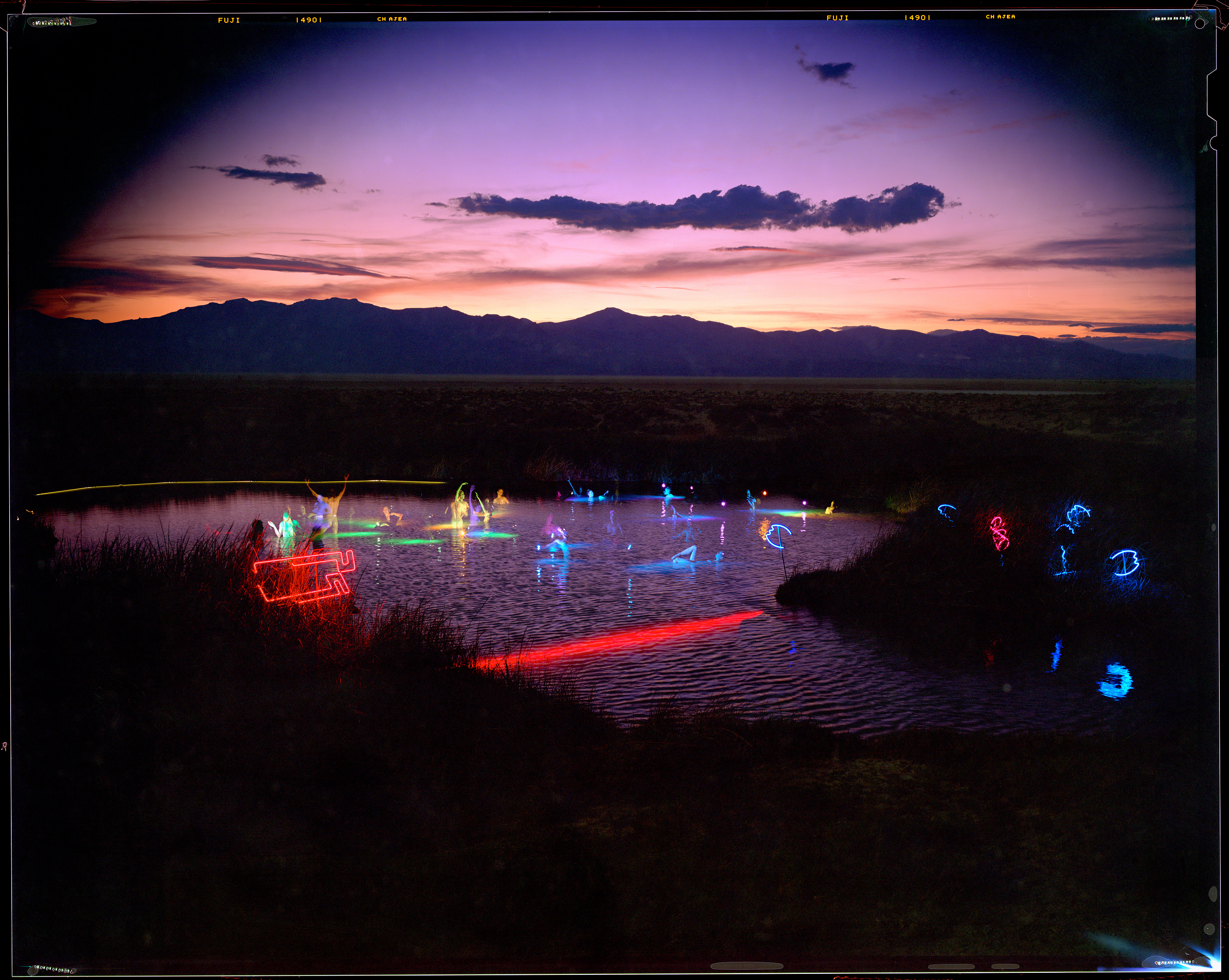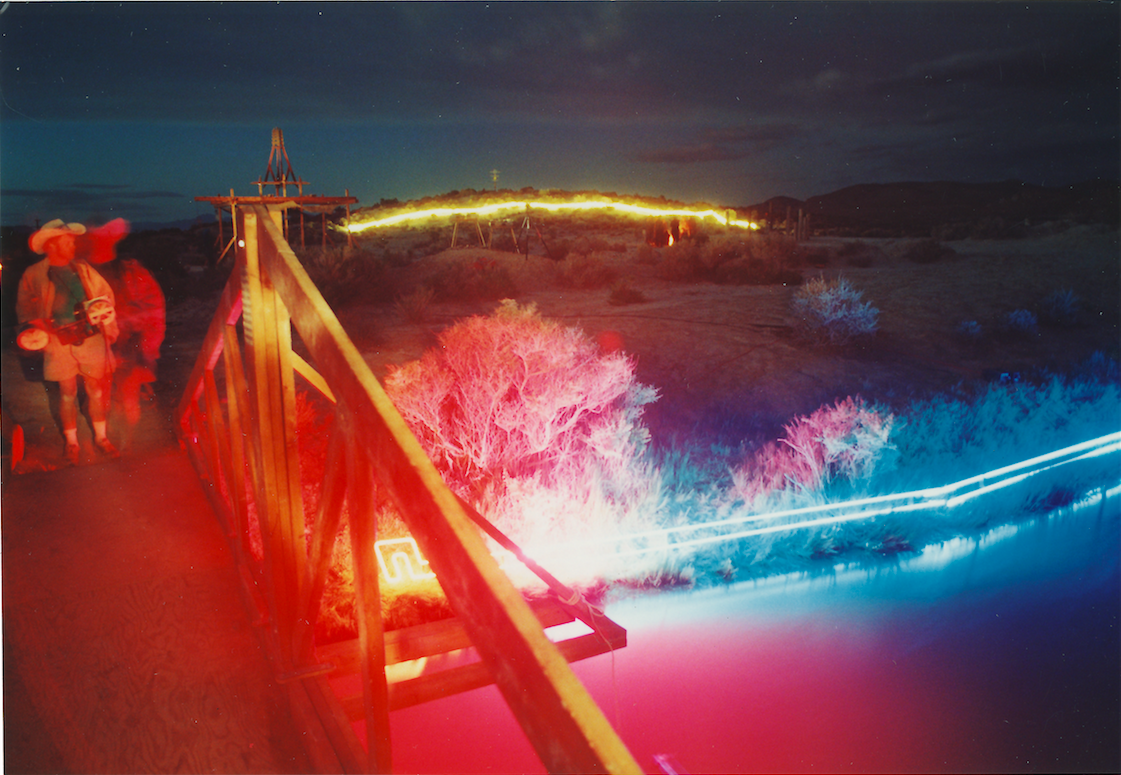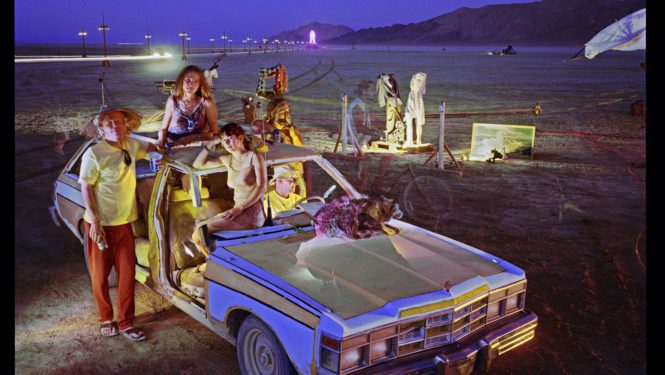Ever wondered why, if Burning Man was invented by punk rockers and industrial artists, the event doesn’t just look like a straight Mad Max and Tank Girl desert cosplay arena? Where did all the splashes of color on shabby-sophisticated tableaus come from?
Answer: William Binzen, Burning Man’s original visual thought leader. In the early ’90s when the Cacophony Society had their “Zone Trip” to the desert, Binzen was holed up in some nearby hot springs and expansive views, doing his own thing as well as collaborating over here on the Black Rock.
Pretty much Binzen is the primary visual conceptual artist and photographer of Burning Man, contributing greatly to the event’s aesthetic. According to many, Desert Siteworks was the event from which Burning Man selected its philosophy and culture.
But let’s have Mr. John Law tell about it. This Friday night in San Anselmo, William Binzen and John Law will throw down a Talk of Ages, where the ancestral roots of Burning Man will be laid bare. It’s a must-attend event for hardcore Cacophony Society historians and curious Burners interested in the visual beginnings of our enlightenment city.
Take it away, John:

“An Unintelligible Passionate Yearning Drove Them Out Into The Desert”
by John Law
Co-founder of the Burning Man & co-editor, Tales of the San Francisco Cacophony Society (quote by T.E. Lawrence; written for Binzen’s San Anselmo show)
“There are four separate, yet in some ways related concepts, organizations or philosophies that were integral to the birth and growth of the Burning Man Festival and the attendant subcultures spreading around the world that have been influenced by this ever more popular event.
The first harbinger of things to come was a San Francisco-based movement comprised of pranksters and regular folk known as the Cacophony Society. Cacophony came out of an earlier underground and mysterious secret organization co-founded by a forgotten visionary named Gary Warne and ominously titled the San Francisco Suicide Club. Cacophony was an experiment in urban exploration, street art, pranking, psychogeography and any other odd pursuits members might imagine. Cacophony started in the mid-80s. It spread around the country with the assistance of the burgeoning Internet and thrived into the late ‘90s.
The radical idea that “every member was a creator of their own reality” agreeing to “put their worldly affairs in order” and to “live each day as though it were your last” was at the heart of Cacophony. Another crucial Cacophony philosophy was contained in the simple phrase: “You may already be a member.”
The second crucial idea that ensured BM’s existence was the simple yet profound concept of “The Zone” pioneered by Cacophonist Carrie Galbraith. Taken from her interest in the films of Andre Tarkovsky and novels of Boris and Arkady Strugatsky, The Zone concept was that a person or group could enter into both a physical and a metaphysical space separate from daily “normal” existence, where literally anything could happen. The first Burning Man on the Black Rock Desert was sponsored and organized by Cacophony and listed as an event in its monthly newsletter, Rough Draft, titled “Bad Day at Black Rock, Cacophony Zone Trip #4.”
The third primary influence was a written philosophy collected in a book called TAZ, Temporary Autonomous Zone by Hakim Bey, an East Coast philosopher. Bey (or Peter Lamborn Wilson as he was also known) devised a very compelling theory of creative freedom and anarchistic collaboration that required participants to find a physical space far away from the cloying, civilization-engendered mechanisms of control. They would bring with them everything they needed, and for a period of time do whatever they wanted with absolutely no rules, regulations, laws, or other examples of social, political, economic control, or any other aspect of human oppression. They would then pack up and leave quickly before being noticed (and consequently, mandatorily crushed by the institutions of humankind), only to regroup in total freedom at a later unannounced time in another secret place.
The fourth influence, structurally and critically the most important with regard to the eventual style and look as well as the growing culture of Burning Man, was, without a doubt, William Binzen’s Desert Siteworks series of art ritual events at desert hot springs.

“DSW made an audacious leap and conjoined the seemingly disparate disciplines of large format, multiple exposure art photography with an ongoing, massive scale, multiple-artist-created series of separate yet subtly connected land art installations. In 1992 Binzen recruited Cacophony to assist with his first DSW at Black Rock Springs in an extremely remote corner of the already extremely remote Black Rock Desert. With a crew of about 20 people, mostly Cacophonists, this amazingly beautiful and wild environment was transformed into an ongoing live human performance/land art installation, ultimately captured by Binzen’s large format cameras.
The following year, again with the assistance of Cacophony, Binzen partnered with Judy West, an artist and arts administrator, to produce an ambitious large scale event/art installation/ritual/life experience at another remote Nevada desert hot springs location. West had her office and home at Project Artaud, an artist live-work mecca in San Francisco.
Through her contacts there, and by combing the San Francisco Open Studios weekends, Binzen and West recruited a number of accomplished professional artists, performers and makers to participate in DSW’s second year. This group of exceptional creators combined with the much looser, amateur, yet outrageous sensibilities of Cacophony proved to be very influential on the burgeoning Burning Man aesthetic and culture. Nothing anywhere remotely as ambitious or involved as the Trego Springs DSW project at Summer Solstice, 1993 had yet been attempted at Burning Man.
Approximately 100 artists and pranksters living together, occupying large-scale physical space they fashioned themselves by hand and imagination, manifesting elaborate rituals while adorned with singular habiliments of their own creation was the order of the moment.

“The organic costume creations and tribal cohabitation rituals of the performance troupe Dream Circus inspired generations of “burner fashion” and much of the now commonplace social rituals at the massive, mainstream event. The giant, mud-skinned, steel mesh fire lingam created by the princely, mercurial Pepe Ozan and the attendant wildly primordial and deeply affecting dance ritual evolved into Pepe’s yearly operas, the most powerful and influential collaborative art installations to take place at Burning Man for the next ten years. Pepe’s massive, complex operas predated and inspired David Best’s temples and dozens of future large scale BM collaborations.
The Cacophony custom of “leave no trace” and culture of encouraging extreme and intense, collaborative “real world” experience was a perfect complement to Binzen’s ideas and the aesthetic sensibilities of the other DSW artists. These protean creative eruptions were adopted whole cloth by the nascent and rapidly expanding Burning Man culture.
Binzen’s writings and carefully, lovingly designed philosophies thoroughly informed the “life as art” and “radical self expression and inclusion” concepts that lie at the heart of early Burning Man and continue today as rubric for the corporation that controls the festival and as a self-evident truth for so many who still participate in BM and have taken this essence out into their lives and into the world.
And then there are the photographs.
William Binzen’s images of Burning Man are the most complex and lovingly conjured of the literally millions of photographs of this highly photogenic event. His wizardly captures and preservation of the fantastical tableaus of Desert Siteworks created by a group of artists and pranksters in the desert over the course of only three years in a distant and magical past, are surely some of the most singular images you will ever see.” -John Law, June 2016

Note: You can read an equally compelling essay by the Nevada Museum of Art’s writer William L. Fox on Binzen for the gallery program; it’s posted also on John Law’s home blog.
WILLIAM BINZEN : WAKING DREAM
featuring works from the early years of Burning Man and the Desert Siteworks Project (1992-1994)
JUNE 25 – AUGUST 27
**Special Event: Friday July 29, 7-9 PM**
An Evening of Conversation with William Binzen, John Law, Stefan Kirkeby, & Anne Veh
Original Music and Interpretive Dance Performance @ 6:30PM
LOCATION:
SMITH ANDERSEN NORTH
20 Greenfield Ave.
San Anselmo, CA 94960
Follow Summer Burkes on Twitter.


Factual note, in 1995 it was Ape Theater (a group of ten or12 friends that I pulled together,) not Dream Circus, that took part at DSW. Dream Circus was a later creation of a few members of Ape Theater who went on to produce performances in SF and perform with the immortal Pepe Ozan. R.I.P.
Report comment
As I recall the first Burning Man was constructed of driftwood, about 3 feet tall, in a fire pit at Baker Beach following a silly celebration of the summer solstice. Word!!
Report comment
Would that be one of the ones Mary Grauberger did? When Larry and Jerry showed up in 1986 they brought with them an eight-foot tall effigy made of stick lumber. It got bigger (and the crowds got bigger) as the years went by until the park police asked them not to do it any more.
https://www.youtube.com/watch?v=allN_4ZYuFk
Report comment
Comments are closed.